Volunteers Monitoring North Carolina River Health
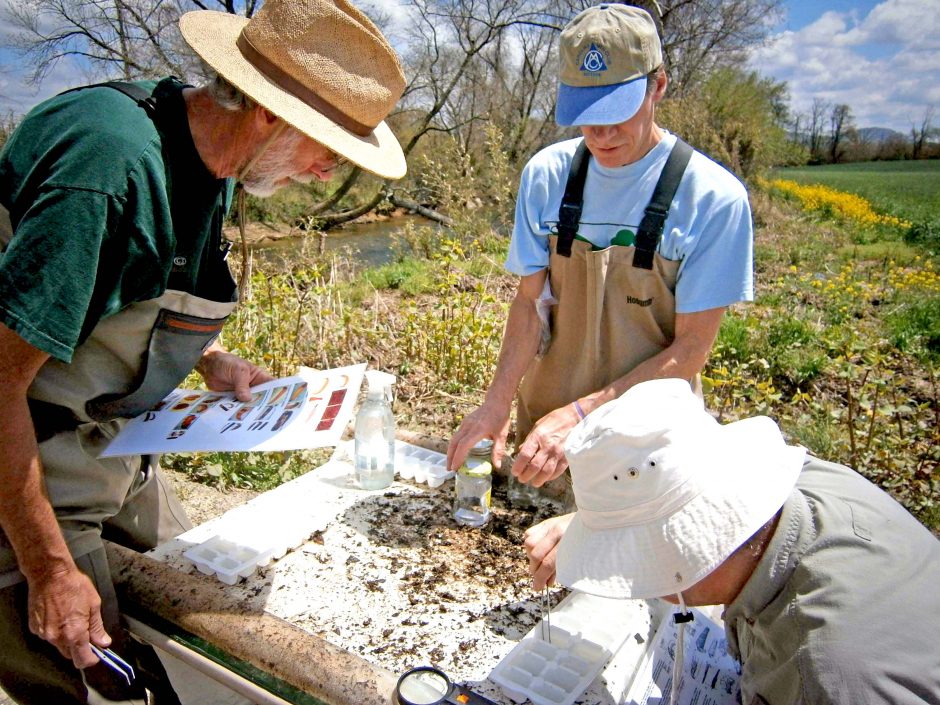
Classifying specimens carefully. (Credit: MountainTrue)
North Carolina is a paradise for anyone who loves being on a river or stream—but that’s only true as long as the water quality in those waterways stays good. Criss-crossed with numerous streams and rivers, the state is home to MountainTrue: a dedicated group of people working to protect watershed health in the state.
Fortunately for them, they’re not doing that work alone. Southern Regional Director and Green Riverkeeper Gray Jernigan spoke to EM about the volunteer programs run by MountainTrue, and the ways those programs extend the reach of the organization.
Volunteer water monitoring programs at MountainTrue
Toward the end of summer 2017, MountainTrue released its state of the river report for the French Broad River—one of the rivers the team monitors—a report that was largely built using volunteer data.
“The Volunteer Water Information Network (VWIN) is a group of volunteers that takes a monthly sample at each of their sites,” explains Mr. Jernigan. “Each sample is analyzed in a lab for eight chemical parameters, including conductivity, pH, total suspended solids, turbidity, ammonia, nitrate, phosphate, and total phosphorus.”
VWIN has been operating for well over 15 years at some locations, and the MountainTrue team is still expanding locations to get a better picture of water quality, watershed-wide.
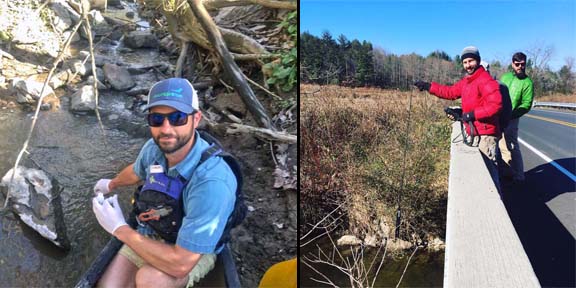
(Left) French Broad Riverkeeper Carson Hartwell taking water samples. (Right) French Broad Riverkeeper Carson Hartwell and Green Riverkeeper Gray Jernigan conducting cold weather bacterial monitoring. (Photo Credit: MountainTrue)
“This way we’re able to see both long-term trends and short-term spikes in pollutant levels that indicate problems,” states Mr. Jernigan. “That really guides a lot of our advocacy; we’ll go out and find the problem areas, and track pollution sources using that data in order to implement a strategy to stop them. That’s a very valuable asset to our work.”
MountainTrue volunteers also have their eyes on the nooks and crannies of the riverbed, watching for benthic macroinvertebrates, an indicator of stream health.
“The second water quality volunteer water quality program that we have is the Stream Monitoring Information Exchange (SMIE),” details Mr. Jernigan. “That is focused on biomonitoring for benthic macroinvertebrates. We have volunteer teams that go out to the streams and look at the insects that are living in the substrate and the leaf pack, count the species, and count the number of individuals.”
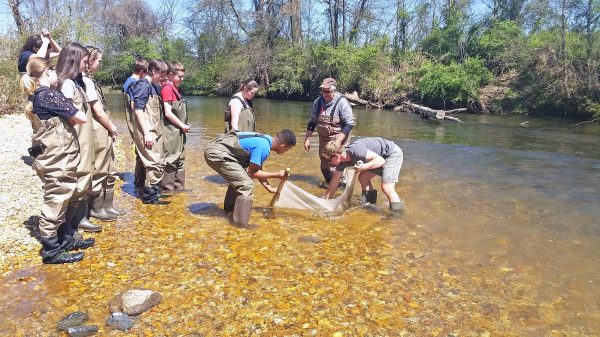
Kids volunteer with MountainTrue. (Credit: MountainTrue)
The team analyzes that data, which all goes into calculating a biotic index. Volunteers collect the data in the fall and in the spring.
“It’s great for looking at long term trends, where we see certain species being impacted,” Mr. Jernigan describes. “All of those species are calculated according to a pollution tolerance, so we can see that if a particular species is not doing well, there may be a problem upstream. That can guide our source tracking work to stop those sources of pollution.”
The data from the program also allows the team to watch long-term trends, including improved water quality that proves a return on their work.
“The third volunteer program we have is called Swim Guide,” states Mr. Jernigan. “That is weekly E. coli testing in the summer months, for public knowledge, for recreation, and just to allow the public to determine if their stream or swimming hole is safe at any given time. And so we’ve published that online and there’s an app called swim guide as well.”
Swim Guide provides long term ratings for the presence or absence of bacteria in local waterways to the public, but the MountainTrue team uses the data practically.
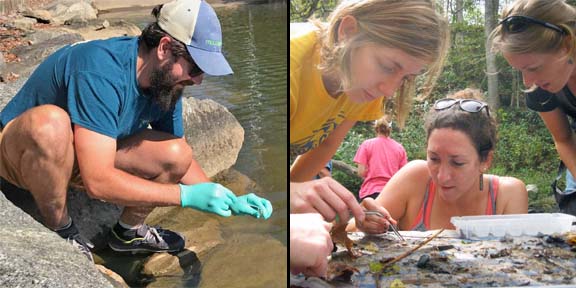
(Left) Gray Jernigan takes a sample. (Right) Volunteers study specimens close up. (Photo Credit: MountainTrue)
“It allows us to do source tracking, and do more intensive bacteria testing to stop problems,” remarks Mr. Jernigan. “For example, we’ve found several livestock operations that had been polluting streams and were able to put a stop to those practices. We’ve been able to identify sewer leaks and work with local municipalities to repair broken infrastructure. So the public awareness aspect of the program is really important, but so is the pollution control aspect.”
Working with the public for cleaner water
The MountainTrue team runs across a wide range of problems, but having more data from various sources is useful to them.
“For the state of the French Broad River report, we looked at all of this volunteer data and combined it with data from the State Department of Environmental Quality, and other existing data sets that from other organizations, and crunched all those numbers to give individual streams an overall score and a ranking,” details Mr. Jernigan. “We used an A through F score, and we confirmed that both urban and agricultural runoff contribute significantly to water quality. It’s not just the cities, and it’s not just the wastewater plants, it’s also agricultural practices and things happening in the less populated areas.”
Knowing the source of problems is important and goes far beyond laying the blame somewhere. In fact, MountainTrue works hard to maintain strong relationships in the community so when it’s time to act on the data, the process is easier.
“In instances where a sewer leaks, we’ve got good relationships with the municipal sewer districts and we can just give them a call and say, ‘Hey, we found a broken sewer pipe, can you get out here and fix it?’” comments Mr. Jernigan. “They’re very responsive. We can work with landowners to get funding for BMPs, and we can also work with state environmental enforcement officials when we have problems that require government intervention. We assess what the problem is and what the best avenues to solve it might be. A one size fits all approach never works with water.”
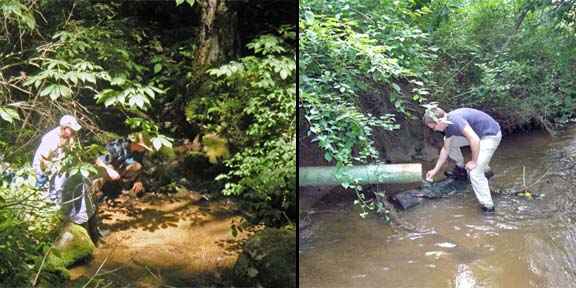
(Left) Sampling benthic macroinvertebrates below a bridge. (Right) Bacterial monitoring in one of the team’s streams. (Photo Credit: MountainTrue)
MountainTrue’s programs are also designed to empower citizen scientists as watchdogs.
“We’ve got some other programs that are focused on empowering citizens with the tools to do their own advocacy,” says Mr. Jernigan. “We developed a phone app called Muddy Water Watch and have trained citizens to spot failing BMPs on construction sites, runoff from land-disturbing activities, and things like that. They simply take a picture of the problem, add a description to it, and submit that directly to us and to state and local enforcement officials.”
According to Jernigan and the MountainTrue team, the programs work, and the data produced by volunteers is invaluable.
“I can’t speak highly enough for our volunteer force,” adds Mr. Jernigan. “We’ve got people that have been participating at our monitoring programs at the same location, who have adopted sites for 20 years or more now. They’re highly invested, and every day we’re recruiting all kinds of new people to expand those programs and give us a better picture of the health of our waterways. We’ve got young folks in college, right out of college, high school students, retirees, people from all walks of life in all different areas. The thing that binds them together is they love our waterways and want to see them thrive.”
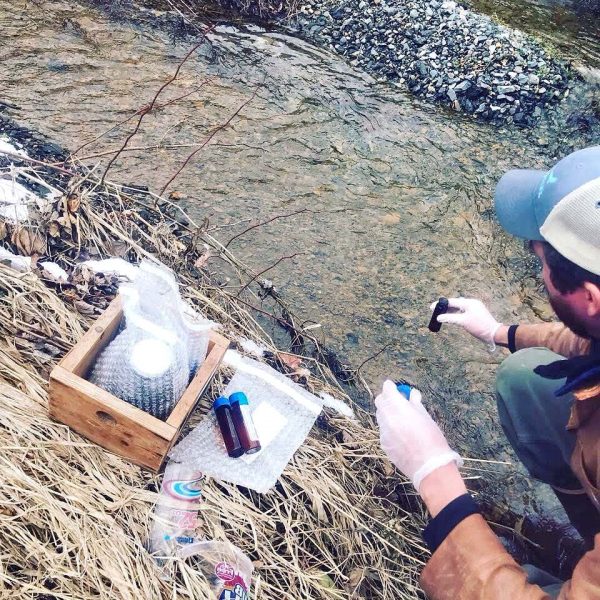
Collecting samples streamside. (Credit: MountainTrue)
The MountainTrue team emphasizes that they simply couldn’t accomplish everything they currently do without this community support.
“It’s something that we couldn’t accomplish, with our staff capacity and our resource capacity, we couldn’t do this work without volunteers,” adds Mr. Jernigan. “We are here to be a resource, so if people see problems in their local waterways, they should feel free to give us a call. And I’d advise them to keep a look out because there are Riverkeeper organizations across the world that are doing this type of work. I’d just encourage people to reach out to their local Riverkeepers see how they can help, and if you see a problem, say something.”
Top image: Classifying specimens carefully. (Credit: MountainTrue)





0 comments